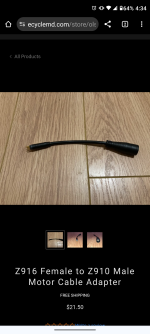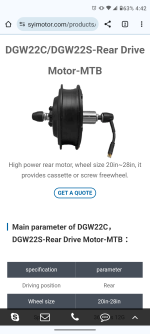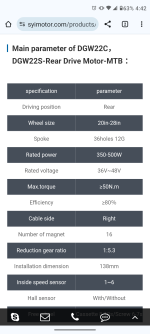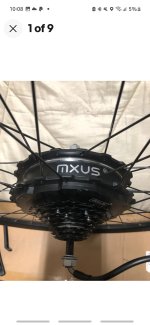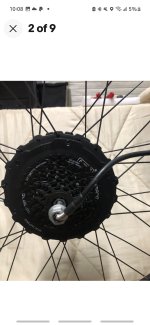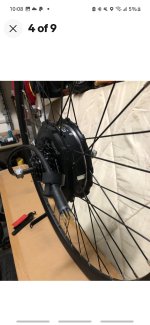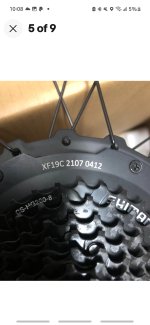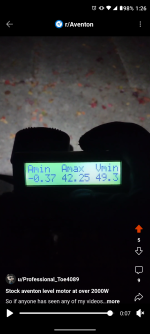You are using an out of date browser. It may not display this or other websites correctly.
You should upgrade or use an alternative browser.
You should upgrade or use an alternative browser.
Baserunner z9 long throttle delay from stop.(Solved)
- Thread starter tnoller5972
- Start date
powerpeddles
1 W
What point are you connecting the temp sensors to? On the board? What about the other end?Those larger wires go to the windings in the motor to run it. Smaller ones underneath go to the board but you don't need to mess with the wiring just simply solder and add on the temp sensor in line with the speed hall.
The temp data gets to the CA via the BR. The BR has a demux chip to split the two signals apart and send them separately, then the CA just displays them so the BR is doing all the work.
tnoller5972
10 W
Yes it gets connected to the board in the motor. One end to ground and the other end to the sensor connection for the speed hall. That's it.
If you look at the video I sent I explain it in detail. In the photo though you can see the 3 pins next to speed hall(HS). The bottom is power, top left is ground leaving the top right which goes to speed hall. The sensor goes in between the speed hall sensor connection and ground on the board. If you zoom in on the pic you should be able to see.
If you look at the video I sent I explain it in detail. In the photo though you can see the 3 pins next to speed hall(HS). The bottom is power, top left is ground leaving the top right which goes to speed hall. The sensor goes in between the speed hall sensor connection and ground on the board. If you zoom in on the pic you should be able to see.
slaphappygamer
100 W
Wow. I was actually researching this very thing. Using a CA and BR on the stock motor. I have the same (or similar) motor on my ride1up 700 (2020 model). I needed a bit more assist for the hilly environment. I have a 25a KT controller, but was looking to add a temp sensor. I’ve also found out that the KT display can’t interpret a combined speedo/therm sensor. I’m currently running the motor at 48v and 25a. Looks like you stuffed the sensor in the windings then epoxied it in place. I’m. not happy about the throttle range that I have, there is a big dead spot in the beginning of the range, about 1/4 of the range is dead zone. I’d like to fine tune that as well as see more battery and rider data. This year, I’m looking to upgrade to a CA and BR Z9. As well as installing a torque sensor. The BaseRunner will free up valuable space in my downtube. I’ve added many accessories and have lots of wire in that cavity.
I have a few questions though. Looking at your videos, I think we are similar weight (155lbs). Are you in a hilly area? What are the grades like? And what did you set your thermal rollback to, on the stock motor? And have you reached that limit?
I have a few questions though. Looking at your videos, I think we are similar weight (155lbs). Are you in a hilly area? What are the grades like? And what did you set your thermal rollback to, on the stock motor? And have you reached that limit?
tnoller5972
10 W
Ok so upon looking it up it looks like the ride 1 up 700 has a fat bike motor. It's still a shengyi but it's the dgw25e, not the DGW22C like on the aventon level. That alone will let you push slightly higher power and torque levels than me. Total bike weight for me is a little over 210lbs. I live in a mostly flat area with some decent hills, but a lot of stop and go traffic that will heat the motor. My limits are at 90c it starts throttling power and 120c it shuts off but it levels out well before 120c. I have short rides so I don't worry to much about the temp, but on longer rides I'll just switch what preset I'm on in the cycle analyst to reduce power so it heats up slower.
One thing I'd recommend is mounting the BR so it can get airflow. If you don't and you install it in the down tube, anything over 25a and for more than a few miles and it will be hot. When mine was in the down tube it got so hot I couldn't hold my finger on its heatsink for more than a sec or two. It was also heating up the down tube battery so that wasn't good.
So if I were you I'd start brainstorming on how you will mount it externally. It's fully potted so it's 100% waterproof. Just if you aren't using all the connectors, cover the ones you aren't using with a rubber cap and some shrink tube.
Also with the CA and BR you can Individually tune the throttle values, when it responds, ramp rates, etc to get rid of that dead zone. I did the same on my bike. The stock throttle started at 1.2v so I needed to move it a good bit to go from rest(.8v) to when the motor starts to move at 1.2v. So I changed the settings so now the throttle responds at .95v so there's virtually no slop/slack in the throttle that does nothing.
One thing I'd recommend is mounting the BR so it can get airflow. If you don't and you install it in the down tube, anything over 25a and for more than a few miles and it will be hot. When mine was in the down tube it got so hot I couldn't hold my finger on its heatsink for more than a sec or two. It was also heating up the down tube battery so that wasn't good.
So if I were you I'd start brainstorming on how you will mount it externally. It's fully potted so it's 100% waterproof. Just if you aren't using all the connectors, cover the ones you aren't using with a rubber cap and some shrink tube.
Also with the CA and BR you can Individually tune the throttle values, when it responds, ramp rates, etc to get rid of that dead zone. I did the same on my bike. The stock throttle started at 1.2v so I needed to move it a good bit to go from rest(.8v) to when the motor starts to move at 1.2v. So I changed the settings so now the throttle responds at .95v so there's virtually no slop/slack in the throttle that does nothing.
tnoller5972
10 W
Yeah you either have the dgw25e or the dgw25p. I would imagine you have the 25p actually due to the fact that the ride 1 up is a sustained 750w bike and the 25e is a 500w motor. They very well could of put it on there if it was a 750w peak bike but being that it's sustained 750w I would imagine they went with the 750w motor(dgw25p)
This being the case you will need an adapter for the motor plug as these larger fat bike motors use a larger octagonal plug rather than the smaller z9 that's on the BR
This being the case you will need an adapter for the motor plug as these larger fat bike motors use a larger octagonal plug rather than the smaller z9 that's on the BR
tnoller5972
10 W
tnoller5972
10 W
Actually never mind I suppose that's the newer models that have that motor but I just seen your post with the motor serial number. Sy2248.......
You do in fact have the same exact motor as me. The 22 isn't for amps as you mention in your post, it's the designation of the motor. This motor is the DGW22C. Scratch everything I said previously then lol.
You do in fact have the same exact motor as me. The 22 isn't for amps as you mention in your post, it's the designation of the motor. This motor is the DGW22C. Scratch everything I said previously then lol.
tnoller5972
10 W
tnoller5972
10 W
tnoller5972
10 W
Yeah I just checked the site for buying a motor wheel and when selecting the 700 series theres 2 different options. If you click the shengyi option, you'll see they mention it won't work for new models of the 700 series. The new ones have a fat motor and sustain 750w and peak at 1000w. That's a bafang motor though with the serial number on the middle rather than the side. So realistically you have the exact same setup as me. I even went to a kt25 for a while myself and it worked good but this is definitely the finished product. My stock controller was only 16a so a max of 750w I'd imagine your was somewhere near this as well so as you I crease power the two main things you will want to do in my opinion are get a temp readout on the hub and see about getting a second battery to parallel like I did. Otherwise you are going to absolutely destroy your battery and it's lifespan as they weren't meant for high power (25a+). Nice thing with the baserunner is you can have phase current high, battery current relatively low and give it some field weakening and you'll have better off line torque and top speed than other setup without killing range by just dumping a ton of battery amps. If you plan to go above 22 to 25a, ride in hilly areas, in a warm climate or have long rides I highly recommend these things
slaphappygamer
100 W
Thanks for the details. I really appreciate it. The bike went through a change after I bought mine. They switched from a Shengyi motor to a bafang and also changed the battery cells from 18650 to 21700. The original Lishui controller was max 22a, but limited to 18a.
I’ve been monitoring the temp on my controller. It was getting very hot and I wanted to exactly how hot. The temp never gets above 50c. I have a stand alone sensor that I glued to the outside shell, opposite the FETs. I think 25a is a good limit for me. I’m not looking to push the battery against the BMS limits. I’m also not looking to go faster, so I’ll most likely leave Field Weakening alone. I’ve been looking at discrete external location options for a controller and under the rear rack might be a good spot. I have bags over the rack and that will keep the sun off the controller, yet it’ll get some airflow underneath the bag. My commutes are 4 miles, one direction.
I was briefly looking at batteries, but mine has been serving me well and I wouldn’t want an external battery. I can’t justify the expense.
I’ve been monitoring the temp on my controller. It was getting very hot and I wanted to exactly how hot. The temp never gets above 50c. I have a stand alone sensor that I glued to the outside shell, opposite the FETs. I think 25a is a good limit for me. I’m not looking to push the battery against the BMS limits. I’m also not looking to go faster, so I’ll most likely leave Field Weakening alone. I’ve been looking at discrete external location options for a controller and under the rear rack might be a good spot. I have bags over the rack and that will keep the sun off the controller, yet it’ll get some airflow underneath the bag. My commutes are 4 miles, one direction.
I was briefly looking at batteries, but mine has been serving me well and I wouldn’t want an external battery. I can’t justify the expense.
tnoller5972
10 W
Most controller have a NTC of some kind to reduce power before they get to hot but that's not a bad idea at all. Just remember though whatever you are reading on case temp, I thermal temp will be at least 15 to 20c higher. Even worse with geared hub motors. That's why it's so crucial to get a temp readout on motor at higher than stock power levels as the way a geared hub is constructed, all the heat is trapped inside and very slowly works it's way to the shell. Gearless hubs can use ferrofluid and heatsinks to improve the thermal connection between the heat producing stator to the rotor/shell so they can get rid of the heat fast.
Geared hubs have a second thermal bridge on top of the normal stator to rotor as geared hubs have a reduction to spin faster. This means the motor itself is separate from the shell. This is why I can push 1500w for 5 miles and be at over 100c on my motor but if I feel the case it's barely warm.
If you are going to be reserved with the limits of the controller and not using field weakening you should be able to mount it internally. Every use case is different. If you take it easy on the controller it should get to hot, I wasn't taking it easy on it though lol.
Geared hubs have a second thermal bridge on top of the normal stator to rotor as geared hubs have a reduction to spin faster. This means the motor itself is separate from the shell. This is why I can push 1500w for 5 miles and be at over 100c on my motor but if I feel the case it's barely warm.
If you are going to be reserved with the limits of the controller and not using field weakening you should be able to mount it internally. Every use case is different. If you take it easy on the controller it should get to hot, I wasn't taking it easy on it though lol.
tnoller5972
10 W
Any time my friend. Best of luck with the project.
Which controllers are those? In the few dozen controllers I've worked with so far, I haven't seen any "ebike" or "scooter" controllers with this functionality yet, short of the Phaserunner v6 I got recently. (even the Grinfineon I have doesn't).Most controller have a NTC of some kind to reduce power before they get to hot
It's possible a large MC-class Kelly I have has this, but the controller doesn't function correctly so can't be used to test this.
I'm sure the Honda IMAs I've got have this, but they're from a car, so....
tnoller5972
10 W
You are right that's my error.
powerpeddles
1 W
Ok so here is what zi have going on, I would love your input,Yes it gets connected to the board in the motor. One end to ground and the other end to the sensor connection for the speed hall. That's it.
If you look at the video I sent I explain it in detail. In the photo though you can see the 3 pins next to speed hall(HS). The bottom is power, top left is ground leaving the top right which goes to speed hall. The sensor goes in between the speed hall sensor connection and ground on the board. If you zoom in on the pic you should be able to see.
I currently have the R1UP MXUS xf19c motor Ride1Up says the motor is 750w and 95nm with a speed sensor and it not clear of there is a temperature sensor. I have heard yes and no but not sure, I can purchase from MXUS the motor core for the 1000w version with an L10190 and temperature sensor but there is no cassette option, I have a 52v 20ah 40amp BMS from UPP but after the recall and stop sell order from Amazon on their products I'm a bit leery of using it.
I'm wondering if there's a benefit to getting the L10 Baserunner, the PhaseRunner or sticking with the original motor and getting a Z9 and doing the temp sensor mod, how much current can the Z9 take? I read 25 amps was the max those cords are rated for. Am I going to see appreciable performance games going to L10 route
Attachments
tnoller5972
10 W
It just depends on what you are looking for. If you are wanting a bike than can really take off and go with higher power and torque levels then yeah I'd say go for it but again then you would be in the same boat of stressing the battery. If you aren't worried about getting the most power and torque and want to use what you already have I'd go with z9. The only real benefit I could see is a higher phase amp limit for higher torque. The z9 goes to 55a battery and the l10 80a. You won't be going over 55a so you won't be using the full potential of the l10 anyway.
If you ask how much current it can take you get different answers across the board. However, grin says in a video modding a rad runner that the small 9 pin z9 connector has no problem with full 55a phase amps. I've had the battery as high as 45a for a max total wattage of 2kw going into the 500w DGW22C.
Over 1k miles of these levels on this hub and the smaller SX2 from grin without problems. No melted connectors or wires. If you are comfortable taking apart the hub and doing a little soldering, I'd use what you have. As far as the 9 pin mxus in the photos id bet it doesn't have a temp sensor as there is only one wire for speed or temp in a 9 pin connector and they always do speed. Grin and maybe some bafang are the only I know of that come with a temp sensor installed already in parallel with the speed hall or combined speed and temp. The l10 version being it has an extra wire is very possible it has a temp sensor installed but then it's on its own wire and you would need the l10.
From what you were saying what you wanted before, I'd say the z9 should be plenty for you as long as you have a temp controlled hub to do thermal rollback automatically.
If you ask how much current it can take you get different answers across the board. However, grin says in a video modding a rad runner that the small 9 pin z9 connector has no problem with full 55a phase amps. I've had the battery as high as 45a for a max total wattage of 2kw going into the 500w DGW22C.
Over 1k miles of these levels on this hub and the smaller SX2 from grin without problems. No melted connectors or wires. If you are comfortable taking apart the hub and doing a little soldering, I'd use what you have. As far as the 9 pin mxus in the photos id bet it doesn't have a temp sensor as there is only one wire for speed or temp in a 9 pin connector and they always do speed. Grin and maybe some bafang are the only I know of that come with a temp sensor installed already in parallel with the speed hall or combined speed and temp. The l10 version being it has an extra wire is very possible it has a temp sensor installed but then it's on its own wire and you would need the l10.
From what you were saying what you wanted before, I'd say the z9 should be plenty for you as long as you have a temp controlled hub to do thermal rollback automatically.
tnoller5972
10 W
tnoller5972
10 W
You'll be much lower though towards 25a tops on one battery though so unless you plan on doing a pack or parallel upgrade you won't see any benefit from the l10 except low end torque(phase amps). You need the power to push those amps (battery) otherwise it's potential isn't being used. I wouldn't bother with the l10 unless you were moving up with motors like getting a gmac or ezee and a battery to match the power levels. Using what you have though and making the most of it with the z9 in my opinion is the better and much cheaper option. Especially if you keep it reserved. You could run 55a phase 25a battery for a max of 1200w and if needed can run up to 20a of field weakening. Anything past 10a is a waste though and just makes heat but my setup with 9a of FW has a top speed of closer to 35mph when fully charged when normally it would be about 28 to 29mph.
powerpeddles
1 W
Thanks for the reply, are you saying the temp sensor upgrade you did would not work with s Z9 plug hub motor? If the battery has a 40 amp BMS (I'm going to have to take it apart as it's a upp battery that might be trash per the findings in the UK) if it's a 40a BMS the BR can max st 30 battery amps right?It just depends on what you are looking for. If you are wanting a bike than can really take off and go with higher power and torque levels then yeah I'd say go for it but again then you would be in the same boat of stressing the battery. If you aren't worried about getting the most power and torque and want to use what you already have I'd go with z9. The only real benefit I could see is a higher phase amp limit for higher torque. The z9 goes to 55a battery and the l10 80a. You won't be going over 55a so you won't be using the full potential of the l10 anyway.
If you ask how much current it can take you get different answers across the board. However, grin says in a video modding a rad runner that the small 9 pin z9 connector has no problem with full 55a phase amps. I've had the battery as high as 45a for a max total wattage of 2kw going into the 500w DGW22C.
Over 1k miles of these levels on this hub and the smaller SX2 from grin without problems. No melted connectors or wires. If you are comfortable taking apart the hub and doing a little soldering, I'd use what you have. As far as the 9 pin mxus in the photos id bet it doesn't have a temp sensor as there is only one wire for speed or temp in a 9 pin connector and they always do speed. Grin and maybe some bafang are the only I know of that come with a temp sensor installed already in parallel with the speed hall or combined speed and temp. The l10 version being it has an extra wire is very possible it has a temp sensor installed but then it's on its own wire and you would need the l10.
From what you were saying what you wanted before, I'd say the z9 should be plenty for you as long as you have a temp controlled hub to do thermal rollback automatically.
tnoller5972
10 W
No it will work. If you go to the larger l10 plug it will not because that has its own wire for speed and it's own wire for temp rather than sharing speed and temp like the z9. The z9 to my understanding is the only one with a demux chip to do this. The BRZ9 can be turned all the way up to 55a battery as well as 55a phase. You can absolutely limit the battery amps in controller to protect the battery. You can even do it in the cycle analyst. When you get it setup there is a max power limit as well so whatever you put in there say 1500w max, it won't draw more than this for a given voltage. So you could be set to 55a battery but it will only draw about 30ish for a 1500w max.
tnoller5972
10 W
For instance I have my BR set to 55a phase and 40amp battery. However I rarely draw that full amount because in my CA I have 3 different presets. High, medium and low. High is full power which is 2000w, medium is at 1500w and low is 1000w. This way the controller can be set and left alone and any changes can be made on the fly with the cycle analyst versus connecting the controller to a computer to change values.
slaphappygamer
100 W
Hey dude, a couple of questions. How have the temps been while riding at 1500w on the stock motor? Also, what epoxy have you used to affix the temp sensor?For instance I have my BR set to 55a phase and 40amp battery. However I rarely draw that full amount because in my CA I have 3 different presets. High, medium and low. High is full power which is 2000w, medium is at 1500w and low is 1000w. This way the controller can be set and left alone and any changes can be made on the fly with the cycle analyst versus connecting the controller to a computer to change values.
tnoller5972
10 W
With the bike in the 1500w mode it gets up to 100°c after about 4 or 5 miles of full throttle riding but that's with almost 10a of field weakening. What I've found is that most of my heating is from field weakening pulling extra power to go faster, this making the losses higher. I run 9.5 a of FW and when in 1500w mode, as long as I try to feather the throttle some and don't have to much stop and go, it usually never gets past 90c.
When you reach 28mph without FW the power drops due to back EMF(motor voltage meeting battery voltage) so even though you are holding 28 to 29mph you are using little power. Going 33-34mph and using field weakening uses much more. I remember you saying you weren't worried about the extra speed so if you don't use FW or if you use a small amount, you shouldn't have any problems.
In my case the temp sensor was put on the windings and a small amount of jb weld high temp epoxy was used to secure it, but I'd recommend a high temp rtv sealant instead as when the jb weld sets up, you can't remove it.
When you reach 28mph without FW the power drops due to back EMF(motor voltage meeting battery voltage) so even though you are holding 28 to 29mph you are using little power. Going 33-34mph and using field weakening uses much more. I remember you saying you weren't worried about the extra speed so if you don't use FW or if you use a small amount, you shouldn't have any problems.
In my case the temp sensor was put on the windings and a small amount of jb weld high temp epoxy was used to secure it, but I'd recommend a high temp rtv sealant instead as when the jb weld sets up, you can't remove it.
Similar threads
- Replies
- 18
- Views
- 1,099


